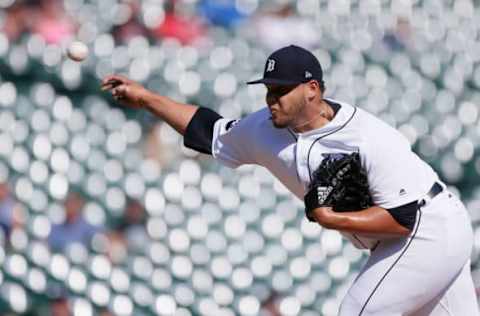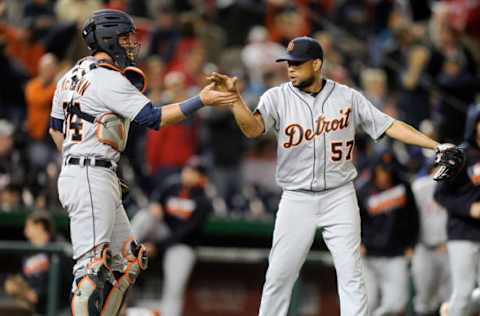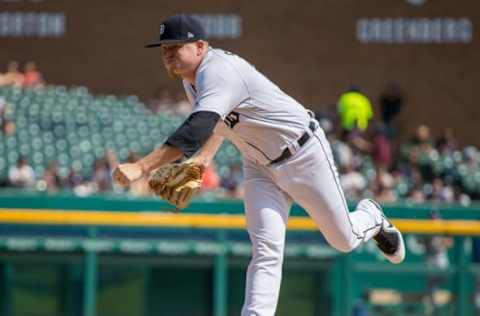Detroit Tigers desperately need bullpen stability in 2018


Detroit Tigers relief pitchers will need to make progress on the field during the 2018 season in order for the franchise’s rebuild to pick up some steam.
Detroit Tigers fans have seen what happens to bullpens when there aren’t defined roles.
During the second half of the 2015 season, Detroit was reeling from the mid-season trades of David Price and Yoenis Cespedes.
The deals netted the team a handful of prospects, including Michael Fulmer, Daniel Norris, Matthew Boyd and Jairo Labourt.
However, the moves sunk Detroit from a record standpoint, as the Tigers ended with a 74-87 tally in the final standings.
The bullpen was also in shambles in the second half. Joakim Soria was also traded at the deadline, while veteran right-hander Joba Chamberlain was cut in mid-July.
That left a bullpen headlined by Alex Wilson, Blaine Hardy, Al Alburquerque and Ian Krol.
While the group struggled, there was no real structure or roles in the relief corps. This started with the closer’s role and trickled down.
During the second half of that season, Bruce Rondon notched five saves, Neftali Feliz had four, while Wilson posted two.
All told, Detroit used 17 pitchers in the second half. Over that span, the Tigers’ bullpen posted the 27th-worst fWAR, the third-highest FIP and the highest SIERA in the league.

2016
Despite the struggles in 2015, Detroit’s relievers were much more successful in 2016.
The unit finished 12th in fWAR and 15th in FIP. The bullpen helped the franchise to an 86-75 record that finished just short of a playoff berth.
What changed?
The Tigers obviously made some offseason additions in the forms of Francisco Rodriguez, Justin Wilson and Mark Lowe that provided an influx of talent.
However, the arrivals of Rodriguez and Wilson also helped the rest of the relievers settle into more consistent roles.
The 2018 bullpen
As it stands, the Detroit Tigers don’t have many established options for new manager Ron Gardenhire to turn to next season.
Closer Shane Greene and setup relief pitcher Alex Wilson are the only proven quantities at this point.
Outside of the duo and perhaps Daniel Stumpf, the rest of the bullpen is full of question marks.
In a perfect world, younger pitchers like Joe Jimenez, Bruce Rondon, Jairo Labourt and Bryan Garcia will take up prominent roles next season, but whether that happens obviously remains to be seen.
While Detroit’s lack of options isn’t ideal, Greene and Wilson’s respective roles as closer and primary eighth-inning option present some stability heading into the season.
The same can be said of Daniel Stumpf as the bullpen’s primary left-handed reliever.

A left-handed bullpen option
Stumpf’s season (0.1 fWAR, 4.49 FIP and a 7.4 swinging strike percentage in 37.2 innings) was by no means perfect in his first year in the Motor City.
However, the southpaw also notched a 80.9 strand rate in 55 appearances, while holding left-handed batters to a .280 wOBA, a .288 slugging percentage and a 1.26 WHIP.
Only 26, If he continues to post numbers like those, he’ll become a useful bullpen option for Gardenhire and company.
By the same token, his presence also allows Labourt to be eased into facing Major League opposition, while also removing the need to lean heavily on Blaine Hardy (5.37 xFIP in 33.1 innings) or Chad Bell (4.79 xFIP in 47 relief frames).
Moving forward
All told, the likes of Greene, Wilson and Stumpf will help the Detroit Tigers bring along the team’s young relievers at a slower pace instead of immediately punting them into the deep end.
A future bullpen consisting of Jimenez, Rondon, Labourt, Garcia, Zac Reininger, Mark Ecker, Paul Voelker and others has the chance to be a dominant force if the group lives up to their potential.
Next: Why Kevin Maitan is the perfect fit for the Tigers
Some stability in 2018 will go a long way towards helping that group reach that potential.